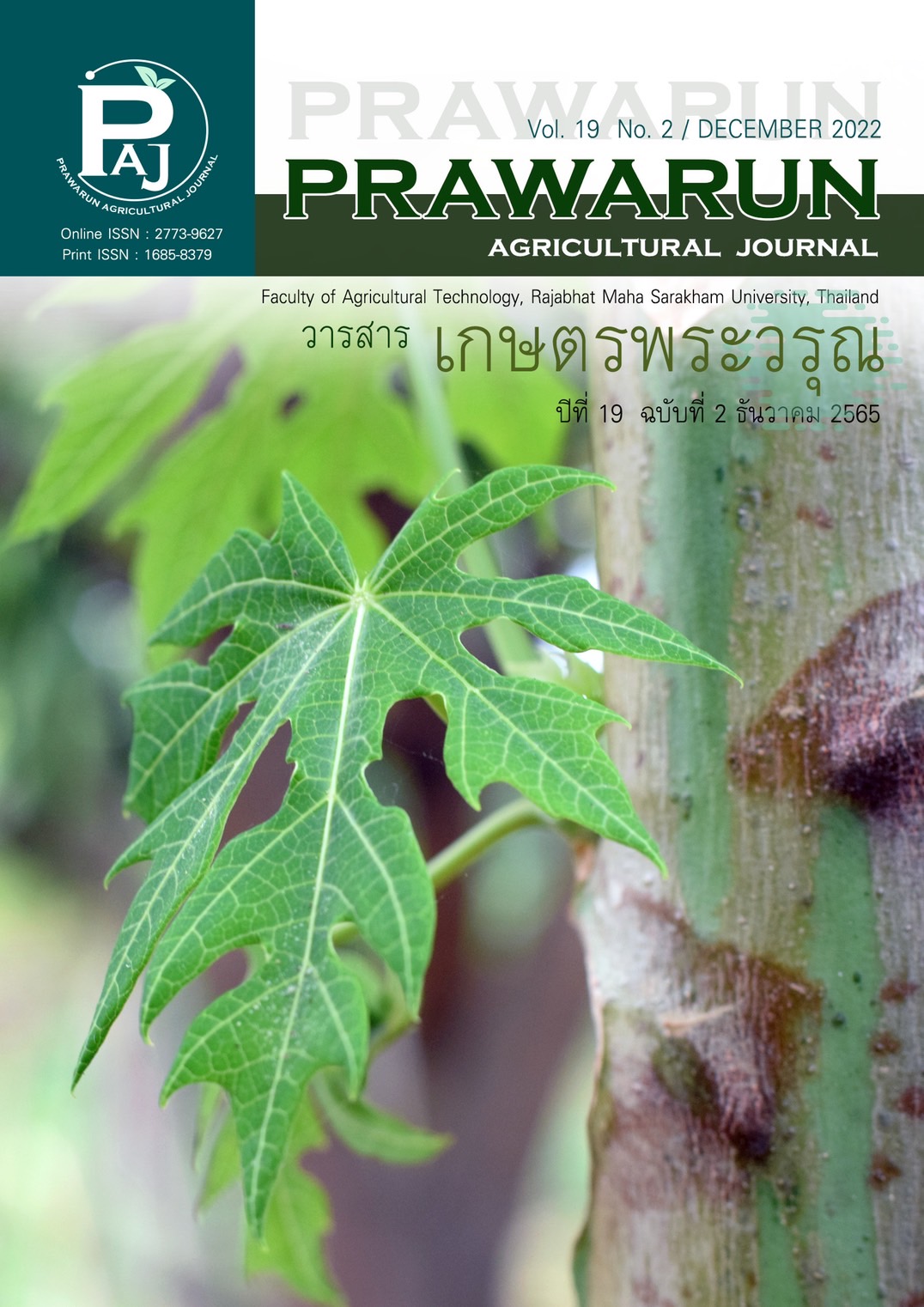การเปรียบเทียบการเติบโตและผลผลิตของต้นกาแฟโรบัสต้าบางพันธุ์ที่ได้จากการเพาะเมล็ด และการเพาะเลี้ยงเนื้อเยื่อในพื้นที่อำเภอบางสะพานน้อย
Main Article Content
บทคัดย่อ
การศึกษานี้เปรียบเทียบการเจริญเติบโตและผลผลิตของกาแฟโรบัสต้าที่ได้จากการเพาะเมล็ดและเพาะเลี้ยงเนื้อเยื่อ เพื่อหาพันธุ์ที่เจริญเติบโตและให้ผลผลิตดีในพื้นที่บางสะพานน้อย วางแผนการทดลองแบบ Split plot in RCBD จำนวน 4 ซ้ำ Main plot คือต้นกาแฟขยายพันธุ์ 2 แบบ คือขยายพันธุ์โดยการเพาะเมล็ดและเพาะเลี้ยงเนื้อเยื่อ Sub plot คือ โรบัสต้า 5 พันธุ์ ได้แก่ ชุมพร 1 ชุมพร 2 ชุมพร 3 ชุมพร 84–4 และชุมพร 84–5 เก็บข้อมูลความสูงต้น เส้นรอบวงโคนต้น ความกว้างทรงพุ่ม จำนวนกิ่งให้ผล ผลผลิตต่อต้น คลอโรฟิลล์และแคโรทีนอยด์ พบว่าการเจริญเติบโตของต้นกาแฟโรบัสต้าที่ขยายพันธุ์จากการเพาะเมล็ดไม่แตกต่างกับที่ขยายพันธุ์จากการเพาะเลี้ยงเนื้อเยื่อโรบัสต้าพันธุ์ชุมพร 84–5 มีการเจริญเติบโตทางลำต้นได้แก่ ความสูงต้น เส้นรอบโคนต้น ความกว้างทรงพุ่ม จำนวนกิ่งให้ผล และผลผลิตต่อต้น ปริมาณคลอโรฟิลล์ และแคโรทีนอยด์ แตกต่างกับพันธุ์อื่นระดับความเชื่อมั่น (P≤0.05) รองลงมาคือโรบัสต้าพันธุ์ชุมพร 84–4 และชุมพร 2 ดังนั้นพันธุ์กาแฟโรบัสต้าพันธุ์ชุมพร 84–5 ชุมพร 84–4 และชุมพร 2 เป็นพันธุ์แนะนำให้กับเกษตรกรในพื้นที่อำเภอบางสะพานน้อย
Article Details
เอกสารอ้างอิง
ACFS. (2018). Thai agricultural standard TAS 5700–2018 robusta green coffee. Bangkok: Ministry of agriculture and cooperatives. (in Thai)
Alemu, I. D., & D. S. Boke. (2017). Morphological characterization of coffee (Coffea arabica L.) landraces at seedling stage collected from GUJI zones. Bangladesh Journal of Plant Breeding and Genetics, 30(2), 9–18.
Antonios, P., loannis, T., Georgios, S. & Stefanos, K. (2012). Effect of water deficit on leaf phenolic composition, gas exchange, oxidative damage and antioxidant activity of four Greek olive (Olea europaea L.) cultivars. Plant Physiology and Biochemistry, 60, 1-11.
Arnon, D. I. (1949). Copper enzymes in isolated chloroplasts. Polyphenol oxidase in Beta vulgaris. Plant Physiology, 24(1), 1–15.
ARDA. (2017). History of coffee and coffee in Thailand. Accessed May 20, 2021. Retrieved from http://www.arda.or.th/kasetinfo/south/coffee /history
Bhatia, P., & Ashwath, N. (2004). Comparative performance of micropropagated and seed–grown tomato plants. Journal of Biologia plantarum, 48(4), 625–628. doi:10.1023/B:BIOP.0000047165.52040.d0
Chantanumat, P., & Kasinkasaempong, Y. (2008). Temporary Immersion bioreactor used temporary immersion bioreactor for robusta coffee propagation via somatic embryogenesis method. Agricultural Science Journal, 39(3) (Suppl), 353–356. (in Thai)
Cilas, C., A., Bar–Hen, Montagnon, C., & Godin, C. (2006). Definition of architectural ideotypes of good yield capacity in Coffea canephora. Annual of Botany, 97, 405–411.
DaMatta, F. M. (2004). Ecophysiological constraints on the production of shaded and unshaded coffee: A review. Field Crops Research, 86, 99–114. doi.org/10.1016/j.fcr.2003.09.001
DaMatta, F. M., & Ramalho, J. D. C. (2006). Impacts of drought and temperature stress on coffee physiology and production: A review. Plant Physiology, 18(1), 55–81. doi.org/10.1590/S1677–04202006000100006
DOA. (2019). Recommended varieties: robusta coffee. Chumphon Horticultural Research Center. Accessed Janurary 9, 2019. Retrieved from https://www.doa.go.th/hc/chumphon/?p=632
DOA. (2020). Coffee strategies: 2017–2021. Accessed February 20, 2022. Retrieved from https://www.doa.go.th/hort/?p=192
DOAE. (2019). Knowledge of increasing production efficiency to become a smart officer: Plant propagation. Bangkok: Department of Agriculture Extension. (in Thai)
Ducos J. P., Alenton, R., Reano, J. F., Kanchanomai, C., Deshayes, A., & Petiard, V. (2003) Agronomic performance of Coffea canephora P. trees derived from large–scale somatic embryo production in liquid medium. Euphytica, 131 (2), 215–223
Jompuk, C. (2009). Statistics: Experimental design and Data Analysis in Plant Research with “R”. Bangkok: Kasetsart University Press. (in Thai)
Kaveeta L. (2016). Plant Structure (2nd ed.). Bangkok: Department of Botany Kasetsart University. (in Thai)
KUKPS. (2018). Soil Properties Analysis. Journal of Agricultural Science and Management, 4(22), 18. (in Thai)
Leelawongsanti, N., Nooha, S. & Samransart, T., (2018). Guidelines of development strategy in thailand 4.0 otop case Study of ,banraichairach coffee ,amphoe bang saphan noi ,changwat prachuap khiri khan. National Conference on Humanities Multicultural society under the transition to Thailand 4.0 era (14th ed). (pp. 250-259). Chiang Rai Rajabhat University. (in Thai)
Liu, X. P., Fan, Y. Y., Long, J. X., Wei, R. F., Kjelgren, R. G., Gong, C. M., & Zhao, J. (2013). Effects of soil water and nitrogen availability on photosynthesis and water use efficiency of Robinia pseudoacacia seedlings. Journal of Environmental Sciences, 25(3), 585–595. doi.org/10.1016/S1001–0742(12)60081–3
Momin, R. K., & Kadam, V. B. (2011). Biochemical analysis of leaves of some medicinal plants of genus Sesbania. Journal of Ecobiotechnology, 3(2), 14–16.
Moran, R. (1982). Formulae for determination of chlorophyllous pigments extracted with N,N–dimethylformamide. Plant Physiology, 69(6), 1376–1381.
Netto, A. T., Campostrini, E., de Oliveira, J. G., & Bressan-Smith, R. E. (2005). Photosynthetic pigments, nitrogen, chlorophyll a fluorescence and SPAD-502 readings in coffee leaves. Scientia Horticulturae, 104(2), 199-209.
OAE. (2021). Agricultural production information: Office of Agricultural Economics. Accessed February 20, 2022. Retrieved from https://www.oae.go.th/view/1/Home/EN–US
Pasutham, T. (2020). The effect of seed size and root pruning on germination and growth of arabica coffee seedling (Coffea arabica L.). (Master’s thesis). Chiang Mai. Maejo University. (in Thai)
Peyanoot, N. (2015). Research on technology of the coffee production to iIncrease the efficiency and cost peduction [Research Project Report]. Chumphon Horticultural Research Center, Horticulture Institute. (in Thai)
Pongsawaeng, K. (1997). Efficacy test of chemical for controlling insect pests of coffee berry borer (Hypothenemus hampei Ferr.) in robusta coffee before harvest (Report 1997–1998, 318–322). Bangkok: Chumphon Horticultural Reseach Center. (in Thai)
Semsanthat, N. (2009). Tissue Culture in Forest Tree (Teaching Publications). Bangkok: Forest Research and Development Office. (in Thai)
Sureerat, P., & Panhathai, N. (2008). Selection characteristics for predicting yield potential of robusta coffee. In N. Chomchalow, V. Chantrasmi, & N. Sukhvibul (Eds.), Proceedings of the International Workshop on Tropical and Subtropical Fruits (pp. 14–146). Chiang Mai, Thailand: Acta Horticulturae. (in Thai)
Vuylsteke D., & Ortiz, R. (1996). Field performance of conventional vs. in vitro propagules of plantain (Musa spp. AAB group). Horticultural science, 31(5), 862–865.
Walaiporn, C. (2008). Study on quality of robusta green been after harvesting [Research Project Report]. Phetchaburi agricultural research and development Center. (in Thai)
Wattanaphut, N. (1999). Plant Propagation. Bangkok: O.S. Printing House. (in Thai)
Wetchakama, N., & Khaengkhan, P. (2018). Improvement of seed qualities with seed priming techniques. Prawarun Agricultural Journal, 15(1), 17–30. (in Thai)
William, R. R., & Linda, P. P. (2006). A comparison of seed–propagated and micropropagated Amelanchier alnifolia (saskatoon): Yield and yield components in relation to crown architecture characteristics. Canadian Journal of Plant Science. 86(2), 499–510. doi:10.4141/P04–167


